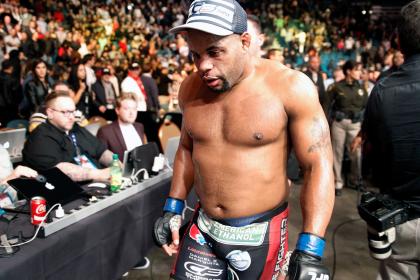Nevada commission: Jon Jones tests results show no signs of doping
LAS VEGAS – Several prominent anti-doping experts publicly suspected UFC light heavyweight champion Jon Jones of using synthetic testosterone after results of a drug test made public earlier this week showed what seemed to be an abnormally low testosterone-to-epitestosterone (T/E) ratio.
But Jones has been cleared of that infraction by carbon isotope ratio (CIR) tests ordered by the Nevada Athletic Commission. Bleacher Report first reported the news.
Only CIR tests can conclusively prove the existence of exogenous, or synthetic, testosterone in the human body. The presence of exogenous testosterone in the body without prior approval is an anti-doping violation.
The analysis of Jones' samples, including CIR testing, taken following his Jan. 3 victory over Daniel Cormier at the MGM Grand Garden still have not been completed. Those results are expected next week. But given the results of the CIR tests already completed, it is highly unlikely that Jones' sample from fight night will show the presence of exogenous testosterone.
Victor Conte, the founder of the Bay Area Laboratory Co-Operative (BALCO), publicly questioned Jones' T/E ratio and was outraged that the Nevada commission hadn't conducted the CIR tests. Conte told Yahoo Sports in multiple interviews on Wednesday and Thursday that Jones' T/E ratios convinced him that something had suppressed Jones' natural testosterone production.
Jones' ratio in the three tests were 0.29:1, 0.35:1 and 0.19.1. The normal ratio for an African-American male is 1.3:1. For Caucasian and Hispanic men, it is about 1:1 and for an Asian, it is about 0.7:1.
Conte developed the cream and the clear in the early part of this century. The clear was actually Tetrahydrogestrinone (THG) and is an anabolic steroid. Conte tested it on himself and said, in four days it completely shut down his body's natural production of both testosterone and epitestosterone.
He said Wednesday he believed Jones had been using something that was suppressing his body's natural testosterone production.
The average amount of testosterone in a male is 61.3 ng/ML per a groundbreaking 1967 study in Clinical Chemistry. In the three tests given to Jones, he had testosterone levels of 1.8 ng/mL, 0.59 ng/mL and 4.9 ng/mL.
"The normal is [much higher], but when you look at his testosterone level, it's 4.9 [ng/mL], meaning it's almost suppressed to zero," Conte told Yahoo Sports Wednesday. "Here's the way this works: Exogenous testosterone, it goes in and attaches to the muscle receptors. You have androgen receptors that are like a cup.
"Once that cup is filled with whatever it may be, it sends a signal back to the pituitary gland to turn the nozzle off and shut the hose for the production of testosterone."
There have been many notable fighters who have failed drug tests for T/E ratios that have been abnormally high. Most jurisdictions consider a T/E ratio of 4:1 normal, though Nevada still uses an older 6:1 threshold.
When Chael Sonnen failed his postfight drug test in California following UFC 117 in 2010, his T/E ratio was 16.9:1. Alistair Overeem had a T/E ratio of 14:1 when he failed a test in 2012.
Budget-strapped regulatory bodies often can't afford to do CIR testing, which costs $450 a test. But because of an uproar among media and fans, the commission decided to conduct the CIR tests on all three of Jones' samples.
He was cleared, though, when the CIR tests indicated no exogenous testosterone.
Jones is in a drug treatment center in New Mexico. He entered on Tuesday, shortly after he announced a random test he was given by the Nevada commission revealed the presence of the primary metabolite in cocaine in his system.
His attorney, the Las Vegas-based Ofir Ventura, declined comment.
Jones has been under heavy scrutiny in the media and the public, with wild speculation raging over the source of his low T/E ratio.
Cormier was actually randomly tested twice by Nevada in December and passed both times. His T/E ratio was similar to Jones, but vastly different in the manner in which it came about, Conte pointed out.

Cormier had a T/E ratio of 0.40:1 on Dec. 2 and of 0.48:1 on Dec. 17. However, his total level of testosterone was far greater than Jones. On Dec. 2, Cormier had 50 ng/mL of testosterone. He had 70 ng/mL on Dec. 17.
Dr. Christiane Ayotte, the head of the WADA-accredited laboratory in Montreal, saw no problem with Jones' T/E ratio.
One way to manipulate a T/E ratio downward would be to take epitestosterone, but Ayotte said that would be easily detected in a screening.
"I read the interviews of 'specialists' on that topic [in MMA media accounts], and, well, I am sorry, but such T/E values are not at all abnormal," she said. " … The administration of epitestosterone is easily detected. It does not give a small increase that looks natural, but a huge peak that is very difficult to control. I have seen only one case of attempted masking with epitestosterone and it was readily detected.
"Epitestosterone is not metabolized rapidly and stays high. An epitestosterone urine sample does not look like the ones you sent me."
Dick Pound, the former president of WADA, is a tax attorney, not a scientist, but he is well-versed in the topic. He said Jones' T/E ratio seemed "suspicious," but praised Ayotte's integrity.
"Christiane is a great scientist and I can guarantee you she's not on anyone's payroll," Pound said. "If she said that, it's what she believes and it's a strong endorsement."
Conte, though, remained suspicious of Jones' test, despite saying repeatedly that a CIR test would prove to be conclusive.
He told Yahoo Sports Thursday that though the T/E ratios of Jones and Cormier were similar, Cormier had normal to slightly-above-average levels of testosterone while Jones levels were significantly lower than average.
